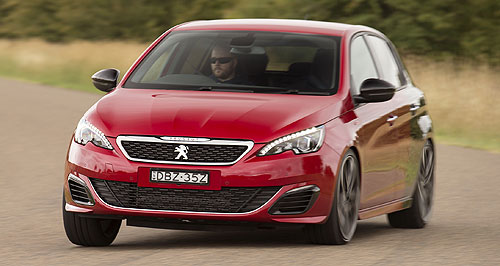Driven: Peugeot 308 GTi cheaper in Oz than in EU
BY BYRON MATHIOUDAKIS | 18th Feb 2016

Launched this week in Tasmania in two guises – the $44,990 250 (for metric horsepower) and $49,990 270 before on-road costs – the T9-series 308 GTi is up to $9000 cheaper than importers Sime Darby Motors Group had envisaged, according to Peugeot Automobiles Australia product planning manager Pavel Meck.
“It was the result of continuing discussions with PSA (Peugeot Citroen Société Anonyme),” he said. “We fought very hard to achieve competitive pricing.” At current exchange rates, the UK-market GTi 250 starts from nearly $A51,700, while in France that price soars to almost $58,700, highlighting the challenges facing the local team attempting to approach the $40,990 base ask of the Golf GTI. “We had to make sure PSA understands how extremely competitive the Australian market is,” added PAA Marketing Manager Dimitri Andreatidis. “If this car is going to be a success, we just couldn’t back down.” While no sales forecasts have been divulged, PAA hopes the 308 GTi will make a sizeable dent in the market shares of European rivals that, apart from the Golf, include the Renault Megane RS, Ford Focus ST and Holden Astra VXR.
So far, it has been buoyed by initial orders that see the more expensive 270 accounting for some 70 per cent of the uptake.
PR and communications manager Tyson Bowen said he hoped the newcomer at least emulated the smaller 208 GTi in snaring at least 20 per cent of total series volume.
“It’s been a long time since we had a car in this segment,” he said. “But as an average on 208, the GTi oscillates between 15 and 25 per cent, if that’s any indication.” With just under 1500 308s registered last year, that would indicate a target of about 300 GTis.
Unlike the Golf GTI with its DSG dual-clutch transmission that accounts for most sales, the 308 GTi is a manual-only proposition, although an automatic alternative to the six-speeder is thought to be under development.
The third production vehicle devised by the Peugeot Sport team after the 208 GTi and RCZ R, the 308 GTi is tasked with recapturing the French brand’s reputation as the hot-hatch king.
To that end, and as outlined when the vehicle was unveiled last winter in Europe, both front-wheel drive variants employ the flagship high-performance version of the 1.6-litre all-alloy four-cylinder turbo Prince petrol engine co-developed with BMW in the middle of last decade.
Aided by direct-injection, a 9.2:1 compression ratio and what PSA calls “strengthened mechanicals”, the 250 produces 184kW of power at 6000rpm and 330Nm of torque from 1900-4000rpm, while the 270 ups the former to 200kW. Both sets of tune share the same 330Nm torque max.
The result is a 0-100km/h sprint-time of six seconds in the 270 (against 5.2s in the 206kW/380Nm Golf R AWD that costs $2750 more) and 6.2s in the 250 (0.3s better than the 162kW/350Nm Golf GTI manual), while top speed is electronically limited to 250km/h.
Fitted with auto idle-stop, the average combined-cycle fuel consumption figure is 6.0 litres per 100km, for a 139 grams/km carbon dioxide emissions rating.
The 308 GTi can be spotted by its black chequer-design grille, be-spoilered front bumper, larger front air intakes, LED headlights and daytime driving lights, side extenders, revised rear diffuser with twin exhaust outlets, series-specific 18-inch or 19-inch alloys, and – if you’re willing to pay $3000 extra on top of the mandatory $1700 special red metallic for the two-tone look – the signature Coupe Franche paintjob. The latter is hand applied and takes up 15 hours.
Built on the EMP2 platform, the 308 tips the scales some 140kg under its predecessor, the GTi brandishes an extensive list of chassis modifications to live up to its Grand Touring Injection badge.
Composites in the tailgate and extensive employment of ultra high-tensile steels contribute, with the resulting 1205kg kerb weight being only 5kg more than the intermediate GT launched nearly a year ago.
The GTi transformation doesn’t stop there, with an 11mm lower ride height, wider tracks (up 11mm up front at 1570mm and 21mm out back at 1554mm), increased front wheel camber, stiffer springs, firmer bushes, recalibrated dampers and thicker anti-roll bars.
The basic suspension set-up continues with MacPherson struts at the front and torsion beam in the rear, but PSA says that both the wishbone stiffness and torsion beam stiffness has been pumped 1600 per cent. Refinement and dynamic capabilities have both been enhanced. Front to rear weight distribution is 63:37.
Additionally, the 270 ushers in a Torsen limited-slip differential for improved cornering (it kicks in at under 35 per cent remaining traction), 19-inch alloys (that are 2kg lighter than the 18-inch 225/40ZR18-tyred wheels on the 250) wearing 235/35ZR19-section Michelin Super Sport tyres, 380mm x 33mm ventilated carbon front discs (up from the 250’s 330mm x 30mm items) with red-painted four-piston callipers, a tyre-inflation kit instead of a temporary spare (that PSA reckons offsets the extra weight of the Torsen LSD) and high-back sports seats.
Speaking of which, all GTis feature more deeply padded front seats, aluminium for the sill covers, gear knob and pedals, red stitching, sports seats, Alcantara trim and revised instrument markings that now include fiery red illumination and additional performance info in Sport mode, complete the visual makeover.
Other standard features include satellite navigation, a reversing camera, keyless entry and start, front parking sensors and rear privacy glass.